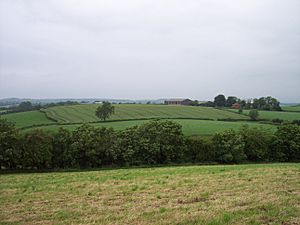Battle of Benburb facts for kids
Quick facts for kids Battle of Benburb |
|||||||
|---|---|---|---|---|---|---|---|
| Part of the Irish Confederate Wars | |||||||
 Monroe's position on Derrycreevy during the Battle of Benburb, seen from the Irish position on Drumflugh |
|||||||
|
|||||||
| Belligerents | |||||||
Scots and English settlers |
|||||||
| Commanders and leaders | |||||||
| Owen Roe O'Neill Rory Maguire |
Robert Monro | ||||||
| Strength | |||||||
| 5,000 | 6,000 | ||||||
| Casualties and losses | |||||||
| c.300 | 2,000–3,000 | ||||||
The Battle of Benburb was a major fight that happened on 5 June 1646. It was part of the Irish Confederate Wars, which were bigger wars happening in Ireland at the time. The battle was fought near Benburb in County Tyrone.
The battle was between the Irish Confederates, led by Owen Roe O'Neill, and an army of Scottish Covenanters. These Covenanters were Scottish soldiers and settlers from England and Scotland. Their leader was Robert Monro. The Irish Confederates won a big victory. This win stopped the Scottish hopes of taking over Ireland and making everyone follow their religious rules.
Contents
Why Did the Battle Happen?
The Scottish Covenanters had sent an army to Ulster in 1642. They wanted to protect the Scottish settlers there after the troubles that followed the Irish Rebellion of 1641. They landed at Carrickfergus and joined up with Sir Robert Stewart and his Laggan Army. This army was made of Protestant settlers from County Donegal.
By 1643, the Covenanters had cleared the northeast of Ulster of Irish rebels. However, they could not move further south. This area was controlled by Owen Roe O'Neill, who was the general of the Irish Confederate army in Ulster.
Who Fought in the Battle?
In 1646, Robert Monro led his forces into the area held by the Confederates. Some people thought he wanted to capture Kilkenny, which was the Confederates' main city. Others believed it was just a large raid.
Monro's army was about 6,000 strong. He had ten groups of foot soldiers, called infantry. Six of these were Scottish, and four were English or Anglo-Irish settlers. He also had 600 horse soldiers, called cavalry, who were Ulster Protestants. Sir Robert Stewart's Laggan Army was supposed to join Monro. But on the day of the battle, they were nearly 30 kilometres away.
Owen Roe O'Neill was usually a careful general. He often avoided big, open battles. However, he had just received help from Giovanni Battista Rinuccini. Rinuccini was a special representative from the Pope in Ireland. He gave O'Neill muskets, ammunition, and money to pay his soldiers. This allowed O'Neill to gather over 5,000 men. His army was a little smaller than Monro's. The Covenanters had six cannons, but the Confederates had none.
How the Battle Unfolded
Monro thought O'Neill would try to avoid his army. So, he made his soldiers march 24 kilometres to meet the Irish force at Benburb. This is in modern south County Tyrone. Gerard Hayes-McCoy, a historian, wrote that many of Monro's soldiers were very tired before the battle even started. Monro's men stood with their backs to the River Blackwater. They faced O'Neill's troops, who were on a small hill.
The Fight Begins
The battle started with Monro's cannons firing at the Irish position. But the cannon fire did not cause many injuries. Then, Monro's cavalry charged at the Irish foot soldiers. However, they could not break through the Confederates' formation of pikemen and musket-men.
The Irish Push Back
When the cavalry attack failed, O'Neill ordered his foot soldiers to move forward. They pushed Monro's forces back towards a bend in the river. This was done by a tactic called the push of pike. The Irish pikes were longer and had narrower heads than their opponents' pikes. This meant they could reach further and were better at piercing.
At this point, Monro's tired soldiers began to struggle. They were slowly pushed back until their battle lines broke apart. The Confederate foot soldiers, led by Rory Maguire, then fired their muskets very close up. They then rushed in with swords and scians (Irish long knives). Monro and his cavalry quickly ran away. Soon after, his foot soldiers also fled. Many of them were killed or drowned as the Irish chased them. Monro's army lost between 2,000 and 3,000 men. The Irish lost about 300 men.
What Happened After the Battle?
O'Neill's victory meant that the Covenanters were no longer a threat to the Confederates. However, they stayed camped around Carrickfergus for the rest of the war. O'Neill did not follow up his victory by chasing them further. Instead, he took his army south. He wanted to get involved in how the Irish leaders were making decisions. He especially wanted to make sure that a peace deal the Irish leaders had signed with the English King's supporters would not be approved.
The battle is remembered in a song called "The Battle of Benburb".

